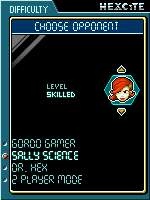Hexcite Fusion, a new puzzle game from Square Enix, is based on a Japanese board game that involves a lot of tangram-style spatial reasoning. Although the game doesn't exploit the possibilities of this setup to the greatest possible extent, it's still a refreshing change from most other puzzle fare on mobile phones, and it's challenging to boot.
You play Hexcite Fusion on a hexagonal grid that's been divided up into six colored, triangular regions, which in turn consist of nine smaller triangles. A player receives nine pieces in each head-to-head match, including larger items like hexagons and triangles (which take up four spaces), medium trapezoids and diamonds, and a handful of small, one-space triangles. The distribution of the pieces offers a little flexibility, so you might receive a few more larger pieces in one game and then receive a few more of the smaller triangles in the next. You score points by rotating and placing your pieces strategically so that their edges line up exactly with either the ring's border or an existing piece on the board. In other words, the first piece placed on the board must touch a side. When you place a piece, you receive five points for every edge that touches another edge. And if you manage to fill up one of the board's six colored regions, you'll receive a sizable bonus score. If you can't play all your pieces during the course of a game, you're penalized 15 points for each remaining shape. Full matches last either two, six, or 10 rounds, and the player with the highest cumulative score wins the match.
There are a couple of basic strategies in Hexcite Fusion. For instance, you can try to place your pieces in such a way that you trick your opponent into almost filling up a bonus zone...and then swoop in to top it off. Or you can prevent your opponent from placing all of his or her pieces so that he or she suffers a penalty at the end of the game. In any case, there's a lot more to the game than you see at first glance, and intriguing new placement options will come to the fore as you continue to play. The game comes with three whimsically named CPU opponents--Gordo Gamer, Sally Science, and Dr. Hex--who provide novice-, experienced-, and expert-level matches, respectively, as well as a pass-and-play two-player option. Gordo's only good for a handful of matches, but Sally Science will hold out for at least several hours of play. Beating Dr. Hex in an extended match is very, very difficult. The game keeps track of your high scores against all three opponents so you can track your progress. However, there are no other game types or online features. Something like a puzzle mode that features tangram shapes or the like would have added to the game's depth.
Hexcite Fusion looks and sounds fine on the LG VX7000. The graphics are adequate for this type of game, and there are a few jingly sound effects to indicate piece selection and placement. In short, there's nothing remarkable about the game's presentation.
Hexcite Fusion is an interesting puzzle game because it calls upon spatial-reasoning skills that most people don't use very often. Although it's not the best puzzle game we've played, it will probably keep most players occupied for a good five to 10 hours. Tangram fans will appreciate it, as will those looking for a solid mental challenge.
